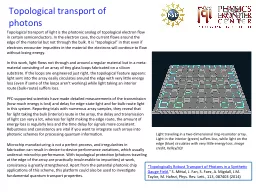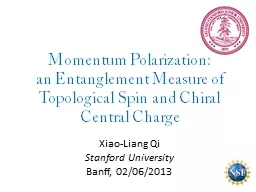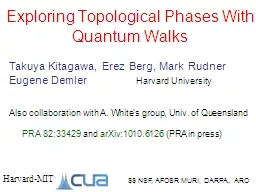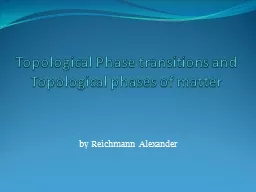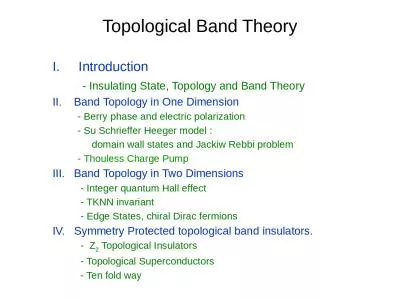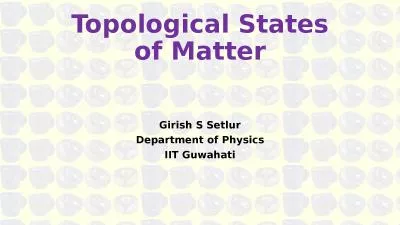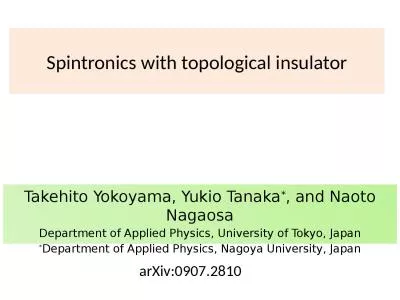PPT-Topological Light "Imaging topological edge states in Silicon photonics," M.
Author : faustina-dinatale | Published Date : 2018-03-18
Hafezi S Mittal J Fan A Migdall JM Taylor Nature Photonics 2013 doi101038nphoton2013274 Topology the understanding of how things are connected remains
Presentation Embed Code
Download Presentation
Download Presentation The PPT/PDF document "Topological Light "Imaging topological e..." is the property of its rightful owner. Permission is granted to download and print the materials on this website for personal, non-commercial use only, and to display it on your personal computer provided you do not modify the materials and that you retain all copyright notices contained in the materials. By downloading content from our website, you accept the terms of this agreement.
Topological Light "Imaging topological edge states in Silicon photonics," M.: Transcript
Hafezi S Mittal J Fan A Migdall JM Taylor Nature Photonics 2013 doi101038nphoton2013274 Topology the understanding of how things are connected remains abstract even with the popular example of doughnuts and coffee cups This concept esoteric as it appears is also neat because it is the basis for creating . Syed. Ali . Raza. Supervisor: Dr. . Pervez. . Hoodbhoy. What are Topological insulators?. Fairly recently discovered electronic phases of matter.. Theoretically predicted in 2005 and 2007 by Zhang, . “Topologically . Robust Transport of Photons in a Synthetic Gauge Field. ," S. Mittal, J. Fan, S. . Faez. , A. . Migdall. , J.M. Taylor, M. . Hafezi. , Phys. Rev. . Lett. ., 113, 087403 (2014. ). Topological transport of light is the photonic analog of topological electron flow in certain semiconductors. In the electron case, the current flows around the edge of the material but not through the bulk. It is “topological” in that even if electrons encounter impurities in the material the electrons will continue to flow without losing energy. Not continuously deformable. Topological. Invariant. Topology & Topological Invariant. Number of Holes. Manifold . of wave functions in the . Hilbert space . r. xy. r. xx. Quantum Hall system:. D. Hilbert. Polarization. : . an E. ntanglement Measure . of . Topological Spin and Chiral Central Charge. Xiao-Liang Qi. Stanford University. Banff, 02/06/2013. Reference: . Hong-. Hao. . Tu. , Yi Zhang, Xiao-Liang Qi, . Symmetry. Topology. Interplay between symmetry and topology has led to a new understanding of . electronic phases of matter.. Conceptual simplification. Conservation laws. Distinguish phases of matter. Lecture 23. a. acyclic with neg. weights (topological sort algorithm). 8/25/2009. 1. ALG0183 Algorithms & Data Structures by Dr Andy Brooks. “The shortest-path algorithms are all . single-source algorithms. Michael Freedman. April 23, 2009. Parsa Bonderson. Adrian Feiguin. Matthew Fisher. Michael Freedman. Matthew Hastings. Ribhu Kaul. Scott Morrison. Chetan Nayak. Simon Trebst. Kevin Walker. Zhenghan Wang. $$ NSF, AFOSR MURI, DARPA, ARO. Harvard-MIT. Takuya Kitagawa, . Erez. Berg, Mark Rudner. Eugene . Demler. . Harvard University. Also collaboration with A. White’s group, Univ. of Queensland. . and. . Topological. . phases. . of. matter. b. y. Reichmann Alexander. Overview. Phase . transitions. Topology. Quantum Hall . effect. Superconductivity. Applications. Phase . transition. Different . Michael Freedman. April 23, 2009. Parsa Bonderson. Adrian Feiguin. Matthew Fisher. Michael Freedman. Matthew Hastings. Ribhu Kaul. Scott Morrison. Chetan Nayak. Simon Trebst. Kevin Walker. Zhenghan Wang. . - Insulating State, Topology and Band Theory. . II. Band Topology in One Dimension. . - Berry phase and electric polarization. - Su Schrieffer . Heeger. model : . domain wall states and . Girish S . Setlur. Department of Physics. IIT Guwahati. COPYRIGHT DISCLAIMER: . ALL ILLUSTRATIONS . AND SOME PASSAGES IN . THESE SLIDES HAVE BEEN DOWNLOADED FROM VARIOUS INTERNET SOURCES.. LISTING EACH SOURCE SEPARATELY WILL TAKE UP ALL MY TIME SO I SHALL DESIST FROM DOING SO.. Takehito. Yokoyama, Yukio Tanaka. *. , and Naoto . Nagaosa. Department of Applied Physics, University of . Tokyo, Japan. *. Department . of Applied Physics, Nagoya . University, . Japan. arXiv:0907.2810. Iris Cong. Dept. of Computer Science, UCLA. Jointly authored with Prof. . Zhenghan. Wang (advisor) and . Meng. Cheng. arXiv:1609.02037. Contents. Introduction. Part I: Hamiltonian Realization. Part II: Algebraic Theory.
Download Document
Here is the link to download the presentation.
"Topological Light "Imaging topological edge states in Silicon photonics," M."The content belongs to its owner. You may download and print it for personal use, without modification, and keep all copyright notices. By downloading, you agree to these terms.
Related Documents

